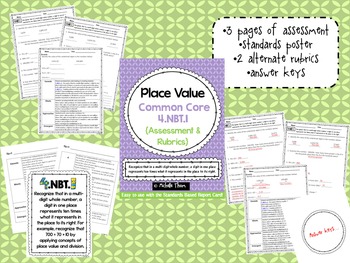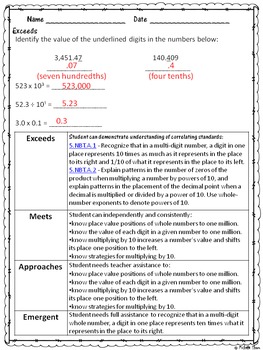Numbers in Base Ten Assessments & Rubrics BUNDLED! {4.NBT.1 - 4.NBT.6}
Michelle Thom
3.3k Followers
Grade Levels
4th
Subjects
Resource Type
Standards
CCSS4.NBT.A.1
CCSS4.NBT.A.2
CCSS4.NBT.A.3
CCSS4.NBT.B.4
CCSS4.NBT.B.5
Formats Included
- Zip
Pages
79 pages
Michelle Thom
3.3k Followers
Description
Included in this packet are assessments for testing Number & Operations in Base Ten Common Core State Standards 4.NBT.1, 4.NBT.2, 4.NBT.3, 4.NBT.4, 4.NBT.5, and 4.NBT.6. A standards poster, an answer key, and two alternate rubrics are also included for each standard!
**NOTE: This is a discounted, BUNDLED pack of my six numbers & operations in base ten assessments & rubrics. The pages included in this bundle are the same as the ones in the individual units listed below:
Common Core 4.NBT.1 {Place Value Assessment & Rubrics}
This standard states that a student can recognize that in a multi-digit whole number, a digit in one place represents ten times what it represents in the place to its right. For example, recognize that 700 ÷ 70 = 10 by applying concepts of place value and division.
Common Core 4.NBT.2 {Read, Write, and Compare Numbers Assessment & Rubrics}
This standard states that a student can read and write multi-digit whole numbers using base-ten numerals, number names, and expanded form. Students can also compare two multi-digit numbers based on meanings of the digits in each place, using >, =, and < symbols to record the results of comparisons.
Common Core 4.NBT.3 {Rounding Assessment & Rubrics}
This standard states that a student can use place value understanding to round multi-digit whole numbers to any place.
Common Core 4.NBT.4 {Standard Algorithm Assessment & Rubrics}
This standard states that a student can fluently add and subtract multi-digit whole numbers using the standard algorithm.
Common Core 4.NBT.5 {Multiplication Assessment & Rubrics}
This standard states that a student can multiply a whole number of up to four digits by a one-digit whole number, and multiply two two-digit numbers, using strategies based on place value and the properties of operations. Furthermore, it states a student can illustrate and explain the calculation by using equations, rectangular arrays, and/or area models.
Common Core 4.NBT.6 {Division Assessment & Rubrics}
This standard states that a student can find whole-number quotients and remainders with up to four-digit dividends and one-digit divisors, using strategies based on place value, the properties of operations, and/or the relationship between multiplication and division. Furthermore, students can illustrate and explain the calculation by using equations, rectangular arrays, and/or area models.
**See preview for samples.
Enjoy :)
Michelle Thom
Like this? You may also want to check out some other common core assessment DISCOUNTED BUNDLES!
Geometry Common Core Assessments & Rubrics BUNDLED! {4.G.1, 4.G.2, 4.G.3}
Fractions and Decimals Assessments & Rubrics BUNDLED! {4.NF.1 - 4.NF.7}
Operations Common Core Assessments & Rubrics BUNDLED! {4.OA.1 - 4.OA.5}
**Also sold individually to fit all needs!
**NOTE: This is a discounted, BUNDLED pack of my six numbers & operations in base ten assessments & rubrics. The pages included in this bundle are the same as the ones in the individual units listed below:
Common Core 4.NBT.1 {Place Value Assessment & Rubrics}
This standard states that a student can recognize that in a multi-digit whole number, a digit in one place represents ten times what it represents in the place to its right. For example, recognize that 700 ÷ 70 = 10 by applying concepts of place value and division.
Common Core 4.NBT.2 {Read, Write, and Compare Numbers Assessment & Rubrics}
This standard states that a student can read and write multi-digit whole numbers using base-ten numerals, number names, and expanded form. Students can also compare two multi-digit numbers based on meanings of the digits in each place, using >, =, and < symbols to record the results of comparisons.
Common Core 4.NBT.3 {Rounding Assessment & Rubrics}
This standard states that a student can use place value understanding to round multi-digit whole numbers to any place.
Common Core 4.NBT.4 {Standard Algorithm Assessment & Rubrics}
This standard states that a student can fluently add and subtract multi-digit whole numbers using the standard algorithm.
Common Core 4.NBT.5 {Multiplication Assessment & Rubrics}
This standard states that a student can multiply a whole number of up to four digits by a one-digit whole number, and multiply two two-digit numbers, using strategies based on place value and the properties of operations. Furthermore, it states a student can illustrate and explain the calculation by using equations, rectangular arrays, and/or area models.
Common Core 4.NBT.6 {Division Assessment & Rubrics}
This standard states that a student can find whole-number quotients and remainders with up to four-digit dividends and one-digit divisors, using strategies based on place value, the properties of operations, and/or the relationship between multiplication and division. Furthermore, students can illustrate and explain the calculation by using equations, rectangular arrays, and/or area models.
**See preview for samples.
Enjoy :)
Michelle Thom
Like this? You may also want to check out some other common core assessment DISCOUNTED BUNDLES!
Geometry Common Core Assessments & Rubrics BUNDLED! {4.G.1, 4.G.2, 4.G.3}
Fractions and Decimals Assessments & Rubrics BUNDLED! {4.NF.1 - 4.NF.7}
Operations Common Core Assessments & Rubrics BUNDLED! {4.OA.1 - 4.OA.5}
**Also sold individually to fit all needs!
Total Pages
79 pages
Answer Key
Included
Teaching Duration
1 Year
Report this resource to TPT
Reported resources will be reviewed by our team. Report this resource to let us know if this resource violates TPT’s content guidelines.
Standards
to see state-specific standards (only available in the US).
CCSS4.NBT.A.1
Recognize that in a multi-digit whole number, a digit in one place represents ten times what it represents in the place to its right. For example, recognize that 700 ÷ 70 = 10 by applying concepts of place value and division.
CCSS4.NBT.A.2
Read and write multi-digit whole numbers using base-ten numerals, number names, and expanded form. Compare two multi-digit numbers based on meanings of the digits in each place, using >, =, and < symbols to record the results of comparisons.
CCSS4.NBT.A.3
Use place value understanding to round multi-digit whole numbers to any place.
CCSS4.NBT.B.4
Fluently add and subtract multi-digit whole numbers using the standard algorithm.
CCSS4.NBT.B.5
Multiply a whole number of up to four digits by a one-digit whole number, and multiply two two-digit numbers, using strategies based on place value and the properties of operations. Illustrate and explain the calculation by using equations, rectangular arrays, and/or area models.





